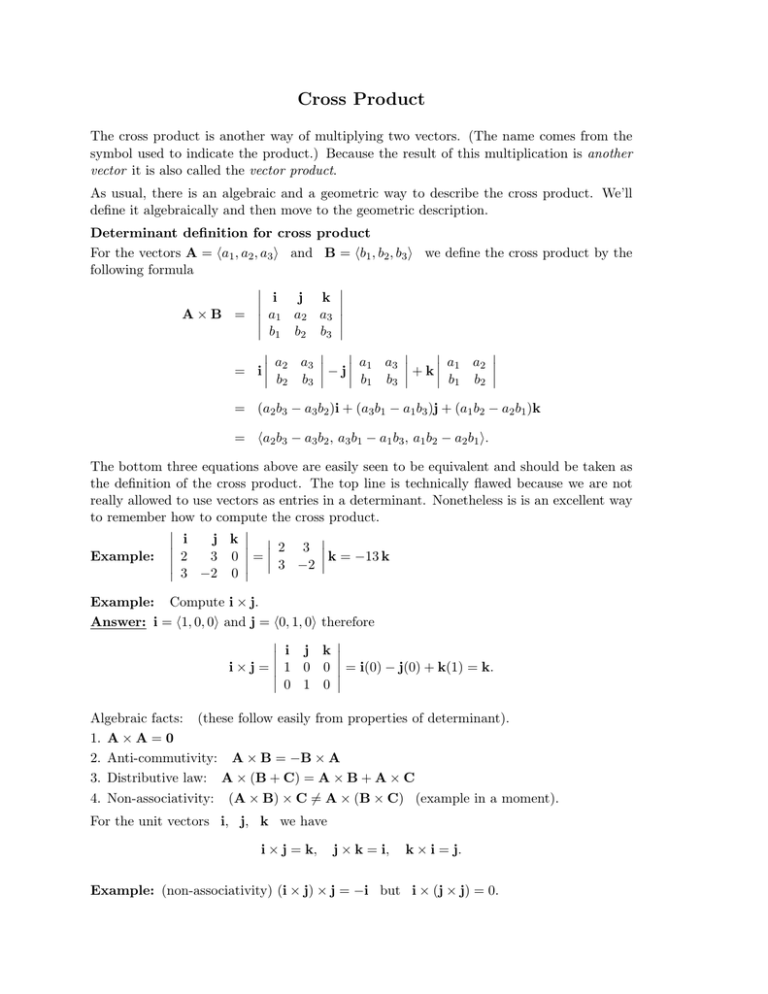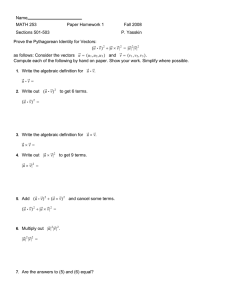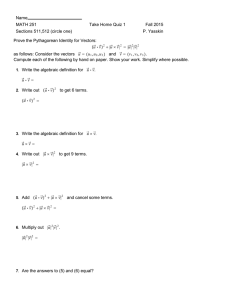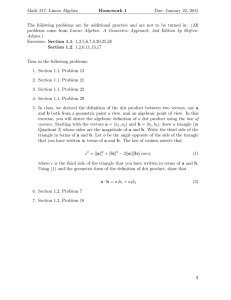Document 13739664
advertisement

Cross Product The cross product is another way of multiplying two vectors. (The name comes from the symbol used to indicate the product.) Because the result of this multiplication is another vector it is also called the vector product. As usual, there is an algebraic and a geometric way to describe the cross product. We’ll define it algebraically and then move to the geometric description. Determinant definition for cross product For the vectors A = �a1 , a2 , a3 � and B = �b1 , b2 , b3 � we define the cross product by the following formula � � � i � j k � � � A × B = � a1 a2 a3 �� � b1 b2 b3 � � � � � � � � a2 a3 � � a1 a3 � � a1 a2 � � − j � � + k � � = i �� � b1 b2 � b2 b3 � � b1 b3 � = (a2 b3 − a3 b2 )i + (a3 b1 − a1 b3 )j + (a1 b2 − a2 b1 )k = �a2 b3 − a3 b2 , a3 b1 − a1 b3 , a1 b2 − a2 b1 �. The bottom three equations above are easily seen to be equivalent and should be taken as the definition of the cross product. The top line is technically flawed because we are not really allowed to use vectors as entries in a determinant. Nonetheless is is an excellent way to remember how to compute the cross product. � � � i � j k �� �� � � 2 3 � k = −13 k 3 0 �� = �� Example: �� 2 3 −2 � � 3 −2 0 � Example: Compute i × j. Answer: i = �1, 0, 0� and j = �0, 1, 0� � � i j � i × j = �� 1 0 � 0 1 therefore � k �� 0 �� = i(0) − j(0) + k(1) = k. 0 � Algebraic facts: (these follow easily from properties of determinant). 1. A × A = 0 2. Anti-commutivity: A × B = −B × A 3. Distributive law: A × (B + C) = A × B + A × C 4. Non-associativity: (A × B) × C = � A × (B × C) (example in a moment). For the unit vectors i, j, k we have i × j = k, j × k = i, k × i = j. Example: (non-associativity) (i × j) × j = −i but i × (j × j) = 0. Example: It is possible to compute a cross product using the algebraic facts and the known products of i, j and k. For example, (2i + 3j) × (3i − 2j) = (6i × i) − (4i × j) + (9j × i) − (6j × j) = −13k. The first equation follows from the distributive law. In the second, we used i × i = j × j = 0 (algebraic fact 1), i × j = k (computed above) and j × i = −k (anti-commutivity). Geometric description To describe the cross product geometrically we need to describe its magnitude and direction. This is done in the following theorem. Theorem: The magnitude of A × B is |A × B| = |A||B| sin θ, where θ is the angle between them = area of the parallelogram spanned by A and B. The direction of A × B is determined as follows. A × B is perpendicular to the plane of A and B. In the figure below there are two directions perpendicular to the plane –up and down. The choice is made by the right hand rule. This rule says to take your right hand and point your fingers in the direction of A so that they curl towards B; then your thumb points in the direction of A × B. dir. A × B from the right hand rule A×B B θ |A × B| = area = |A||B| sin θ A We will not go through the proof of this theorem. It makes use of the Lagrange identity |A × B|2 = |A|2 |B|2 − (A · B)2 . z This identity is easily show by expanding both sides using components. Example: Find the area of the triangle shown. (1, 2, 4) Answer: The area of the triangle is half the area of the parallelogram (see figure). 1 So, area triangle = |�1, 2, 4� × �0, 5, 1�|. 2 � � � i j k � � � �1, 2, 4� × �0, 5, 1� = �� 1 2 4 �� = i(−18) − j + 5k. � 0 5 1 � 1 � 2 1√ Area triangle = 18 + 12 + 52 = 350. 2 2 (0, 5, 1) y O z x �1, 2, 4� x DON’T FORGET THE GEOMETRY -it will be used to solve problems. �0, 5, 1� y MIT OpenCourseWare http://ocw.mit.edu 18.02SC Multivariable Calculus Fall 2010 �� For information about citing these materials or our Terms of Use, visit: http://ocw.mit.edu/terms.




